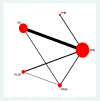Comparing surgical interventions for intertrochanteric hip fracture by blood loss and operation time: a network meta-analysis
- PMID: 29929525
- PMCID: PMC6013997
- DOI: 10.1186/s13018-018-0852-8
Comparing surgical interventions for intertrochanteric hip fracture by blood loss and operation time: a network meta-analysis
Abstract
Background: Multiple operative treatments are available for the fixation of intertrochanteric femoral fractures. This analysis was conducted to provide guidance on the appropriate clinical choice to accommodate individual patients.
Methods: A systematic review was performed to identify relevant articles in databases. Randomized controlled trials (RCTs) of adults with intertrochanteric femoral fractures were eligible if they compared 2 or more of the following interventions: proximal femoral nail anti-rotation (PFNA), percutaneous compression plate (PCCP) use, dynamic hip screw (DHS) fixation, gamma nail (GN) fixation, and artificial femoral head replacement (FHR). Bayesian network meta-analysis was performed to simultaneously compare all treatment methods.
Results: In total, 24 active-comparator studies involving 3097 participants were identified. Across all populations, greater reductions in blood loss and operation time were observed for PFNA than for other treatments. In terms of bleeding, more blood loss was observed for DHS use than for the PFNA (SMD, 1.96; 95% CI, 1.01-1.96), PCCP (SMD, 1.26; 95% CI, 0.31-2.20), and GN (SMD, 0.26; 95% CI, - 0.35-0.87) techniques. However, a more beneficial effect was observed for DHS use than for FHR (SMD, - 0.23; 95% CI, - 1.26-0.81). DHS use resulted in a significantly longer duration of operation time than the PFNA (SMD, 0.75; 95% CI, - 0.02-0.75), PCCP (SMD, 0.61; 95% CI, - 0.20-1.44), and GN (SMD, 0.25; 95% CI, - 0.26-0.77) techniques. Similarly, greater reductions in operation time were observed for DHS use than for FHR (SMD, - 0.12; 95% CI, - 1.15-0.91).
Conclusions: The findings provide supporting evidence demonstrating the superiority of PFNA over other treatments for intertrochanteric femoral fracture. PFNA treatment results in the lowest amount of blood loss and the shortest operation time. These findings add to the existing knowledge of intertrochanteric femoral fracture treatment options.
Keywords: Intertrochanteric hip fracture; Meta-analysis; Surgical intervention.
Conflict of interest statement
Ethics approval and consent to participate
Not applicable.
Competing interests
The authors declare that they have no competing interests.
Publisher’s Note
Springer Nature remains neutral with regard to jurisdictional claims in published map and institutional affiliations.
Figures




Comment in
-
Letter to the Editors: Comparing surgical interventions for intertrochanteric hip fracture by blood loss and operation time: a network meta-analysis.J Orthop Surg Res. 2019 May 22;14(1):144. doi: 10.1186/s13018-019-1195-9. J Orthop Surg Res. 2019. PMID: 31118059 Free PMC article. No abstract available.
References
-
- Aktselis I, Kokoroghiannis C, Fragkomichalos E, Koundis G, Deligeorgis A, Daskalakis E, et al. Prospective randomised controlled trial of an intrame-dullary nail versus a sliding hip screw for intertrochanteric fractures of the femur. Int Orthop. 2014;38:155–161. doi: 10.1007/s00264-013-2196-7. - DOI - PMC - PubMed
Publication types
MeSH terms
LinkOut - more resources
Full Text Sources
Other Literature Sources
Medical

